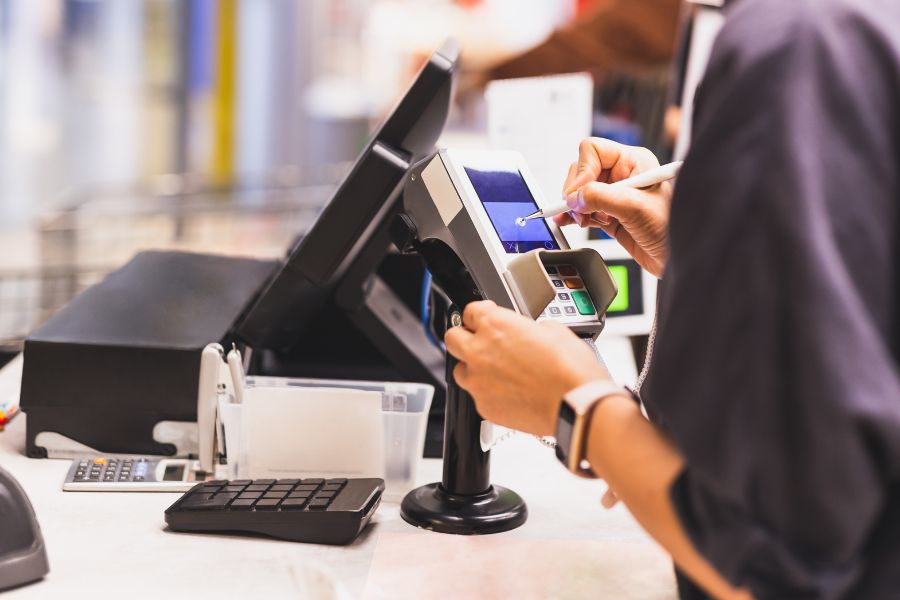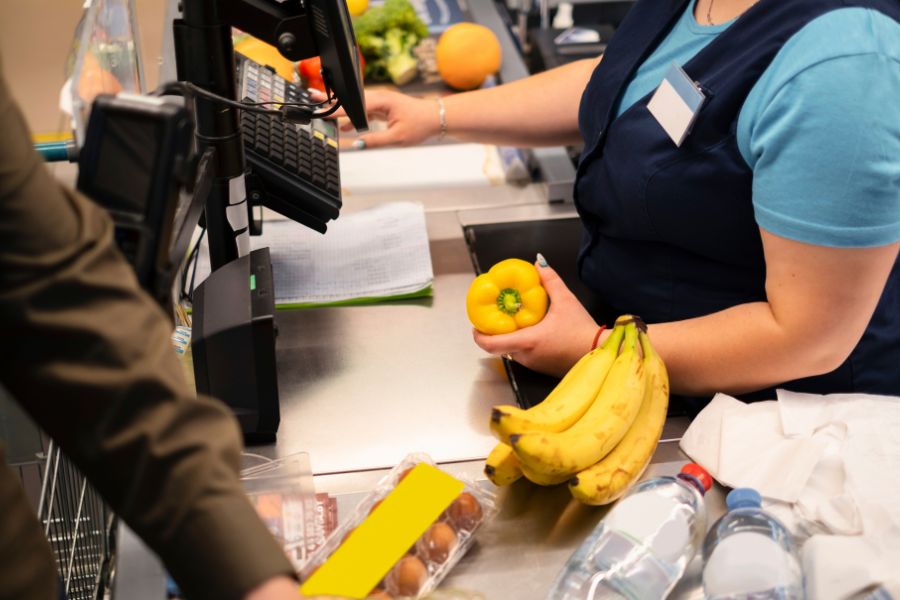Electronic point of sale systems are the backbone of modern retail operations. With rapid advancements in technology, they are transforming how businesses function and interact with customers. As we move closer to 2025, the integration of cutting-edge technologies promises to revolutionize the retail industry.
This article explores the key trends shaping the future of electronic POS systems and how retailers can stay ahead of the curve.
Highlight:
- POS systems will seamlessly connect physical, online, and mobile platforms for a unified customer experience.
- Predictive analytics and AI will drive smarter inventory, pricing, and customer experience strategies.
- Tokenization and biometric authentication will protect customer data and reduce fraud.
Future of Electronic Point of Sale for Retail in 2025
In 2025, the retail landscape will look markedly different. As consumer behaviors evolve, retailers must adopt new strategies and technologies to remain competitive.
There are 8 key electronic point of sale trends poised to make a significant impact the year:
Seamless Integration with Omnichannel Retail
Omnichannel retail is no longer optional; it is essential for survival in a competitive market. By 2025, POS systems will enable retailers to integrate physical stores, online platforms, and mobile apps seamlessly.
For instance, Target reported a 30% increase in sales after integrating its in-store and online inventory, enabling customers to buy online and pick up in-store.
Future electronic point of sale systems will facilitate real-time inventory tracking, order management, and customer data synchronization, ensuring a cohesive shopping experience across all touchpoints.
Advanced-Data Analytics for Deeper Insights
Retailers are increasingly relying on data to make informed decisions. Advanced POS systems will incorporate predictive analytics to uncover hidden patterns in customer behavior and sales trends.
For example, Amazon Go uses AI-driven analytics to monitor purchasing habits and stock its shelves accordingly, reducing out-of-stock instances by 15%. With these insights, businesses can optimize pricing strategies, target promotions, and forecast demand with unprecedented accuracy.
Personalized Automation Through AI
Artificial Intelligence (AI) is set to revolutionize POS systems by automating routine tasks and providing data-driven insights. It will empower POS systems to process vast amounts of data, automate decision-making, and offer tailored customer recommendations, improving operational efficiency and engagement.
A notable example is IBM Watson Order Optimizer, an AI solution designed to integrate with POS systems. It improves order fulfillment by balancing inventory, reducing costs, and enhancing supply chain efficiency.
Mobile and Contactless Payments as Standard
The future of retail will see an explosion in mobile and contactless payments, as well as the integration of digital wallets and cryptocurrency options. This shift aligns with consumer preferences and the global move toward a cashless society.
Embracing multiple payment options enhances customer convenience, accelerates transactions, and appeals to a wider audience. Businesses adopting these methods are well-positioned to meet the needs of tech-savvy customers.
Trending payment options include:
- Mobile and contactless payments: Digital wallets like Google Wallet, Apple Pay, PayPal, Venmo, and CashApp are gaining popularity. While accounting for only 6% of POS transactions in 2019, this figure is expected to reach 15.5% by 2024.
- Amazon Pay: Launched in 2007, Amazon Pay has grown significantly, now supporting 5 million merchants and offering tools like the Amazon Pay for Business app.
- Installment payments: Many POS systems now provide installment options, even without BNPL services. These plans boost conversions, average order value, and customer retention, especially for consumers with limited access to credit.
- Loyalty and rewards programs: Integrated customer loyalty programs drive repeat purchases and increase lifetime value by rewarding ongoing engagement.
If you are looking for seamless payment solutions, ConnectPOS is where it provides mobile and contactless payments. ConnectPOS systems that support diverse payment methods, including QR codes, NFC, and digital wallets, will reduce checkout times and enhance customer satisfaction.
Heightened Security in POS Solutions
As digital transactions dominate retail, cybersecurity risks are becoming a growing concern. In 2025, enhanced security will be a cornerstone of electronic point of sale systems, incorporating advanced technologies to protect both retailers and customers from evolving threats.
One of the most critical innovations is tokenization, which replaces sensitive payment details with unique, encrypted tokens during transactions. This ensures that even if hackers intercept the data, it is meaningless without the decryption key.
For example, Apple Pay uses tokenization to secure transactions, reducing fraud rates by 60% compared to traditional payment methods. Similarly, encryption protocols will ensure that all data transferred between POS systems and payment networks is fully secured, rendering it inaccessible to cybercriminals.
Another key development is the integration of biometric authentication, such as fingerprint or facial recognition, into POS systems. This layer of security not only enhances user convenience but also significantly reduces the risk of unauthorized access.
AI-Driven Inventory Optimization
AI-powered POS systems will revolutionize inventory management by predicting demand based on historical data, seasonal trends, and market conditions.
For instance, Walmart reduced stockouts by 30% by implementing AI-driven inventory tools. These systems will automate restocking processes, minimize excess inventory, and improve cash flow, enabling retailers to maintain optimal stock levels.
Industry-Specific POS Customization
As the retail landscape diversifies, different industries face unique operational challenges that require tailored solutions. In 2025, POS systems will become increasingly customizable to meet the specific needs of sectors such as grocery, cannabis, and hospitality
A standout example in this space is ConnectPOS, which specializes in offering highly customizable POS systems for various industries, including retail, restaurants, and cannabis. This adaptability supports businesses in operating seamlessly while adhering to their sector’s specific requirements.
For instance, grocery stores often manage complex inventory, including perishable goods, variable-weight products, and barcode scanning. ConnectPOS addresses these needs with features like weighted product scanning, inventory syncing, and automated stock alerts, enabling grocers to maintain accurate inventory and reduce waste.
In the cannabis industry, ConnectPOS integrates age verification, product tracking, and compliance reporting directly into the POS system.
Subscription-Based POS Software Models
The subscription-based model is rapidly becoming the preferred choice for retailers due to its flexibility, scalability, and cost-effectiveness. Unlike traditional POS systems that require significant upfront investments, subscription-based POS software, often delivered as Software-as-a-Service (SaaS), provides businesses with access to advanced features through affordable monthly or annual plans.
According to a Deloitte survey, 65% of small businesses now favor SaaS-based POS solutions for their affordability and the regular updates they offer. This model eliminates the need for costly hardware upgrades and ensures businesses always have access to the latest functionalities, such as cloud backups, remote management, and multi-location support.
For example, Shopify POS offers tiered subscription plans to cater to businesses of all sizes. Their plans include real-time inventory tracking, omnichannel integration, and customer loyalty tools, enabling retailers to choose a package that matches their needs and budget. Small businesses can start with a basic plan and scale up as they grow, ensuring they only pay for the required features.
How Retailers Can Adapt Their Electronic POS Systems For 2025
As we approach 2025, retailers must evolve their electronic point of sale systems to stay competitive and meet the growing expectations of modern consumers. To remain at the forefront, here are key adaptations retailers should consider:
- Embrace Cloud-Based Solutions: Moving to cloud-based POS systems allows retailers to manage multiple locations seamlessly, access real-time data, and reduce operational costs associated with traditional hardware.
- Integrate AI and Machine Learning: By leveraging AI-driven insights, retailers can personalize customer experiences, predict purchasing behavior, and optimize inventory management. Machine learning algorithms can also refine pricing strategies and enhance decision-making.
- Support Mobile and Contactless Payments: With growing demand for mobile payments and contactless transactions, retailers should ensure their POS systems are compatible with mobile wallets, NFC technology, and biometric authentication for secure and efficient transactions.
- Enhance Security Features: Protecting customer data remains critical. POS systems should be equipped with advanced encryption, AI-based fraud detection, and compliance with global security standards like PCI DSS to safeguard transactions.
FAQs: Electronic Point of Sale
- What is the main focus of POS innovation in 2025?
The main focus of POS innovation in 2025 will be AI integration, cloud-based systems, contactless payments, and enhanced security features, aiming to improve efficiency, personalization, and customer experience.
- How will AI improve POS systems?
AI will improve POS systems by offering predictive analytics, personalized customer experiences, real-time inventory management, and dynamic pricing, enabling retailers to make data-driven decisions and optimize operations.
- Are biometrics secure for payments?
Yes, biometrics are highly secure for payments as they use unique physical traits like fingerprints or facial recognition, ensuring accurate identification, reducing fraud, and providing secure, frictionless transactions.
Conclusion
The future of electronic point of sale systems in 2025 promises to transform the retail industry with cutting-edge technologies such as AI, cloud-based solutions, enhanced security, and seamless payment methods. Retailers must adapt to these advancements to stay competitive, streamline operations, and provide exceptional customer experiences.
For retailers looking to future-proof their POS systems, contact us today to explore how their innovative POS solutions can elevate your business and enhance your retail operations in 2025 and beyond.
ConnectPOS is a all-in-one point of sale solution tailored to meet your eCommerce POS needs, streamline business operations, boost sales, and enhance customer experience in diverse industries. We offer custom POS with features, pricing, and plans to suit your unique business requirements.




